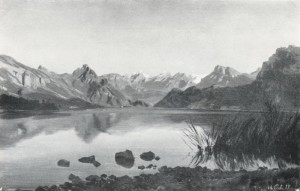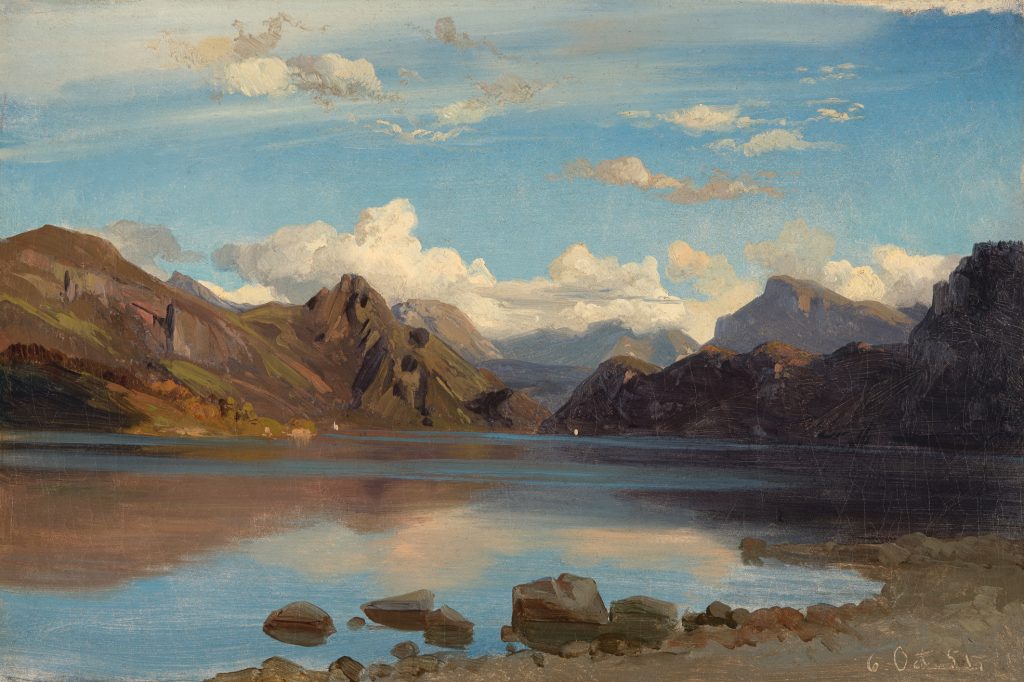Robert Zünd (1827 - Lucerne - 1909)
View over Lake Lucerne towards Mount Rigi, 1855
Oil on canvas, 23.7 x 36 cm
Dated lower right 6. Oct. 55
Estate stamps on the verso; a topographical inscription on the stretcher reads Blick auf (die) Rigi
Provenance:
The artist’s estate
Private collection, Switzerland
Literature:
Hermann Uhde-Bernays, Robert Zünd, Basel 1926, plate VI
I am not willing to part with one single study![1]
Robert Zünd in a letter to Ulrich Gutersohn dated 14 February 1904
Robert Zünd studied painting and drawing in the studio of Jakob Schwegler. He moved to Geneva in 1848, where he worked under two of Switzerland’s leading landscapists, François Diday (1802-77) and Alexandre Calame (1810-64). In 1861 he studied briefly at the Munich Academy where he met Rudolf Koller (1828-1905), a Munich animal painter. A close friendship quickly developed. Zünd first visited Paris in 1852, where he drew inspiration from his discovery of seventeenth-century painting. He returned to Paris on a number of occasions and also visited Dresden and Munich. He married in 1853 and settled near Lucerne. The landscapes of the surrounding countryside were to provide him with a significant repertoire of motifs in the coming years.
Lake Lucerne was one of Zünd’s preferred subjects and he repeatedly returned to the motif to produce studies from different viewpoints and at different times of the day and year. The present oil study dates from his early career and is precisely dated 6. Oktober 1855. It depicts a view over Lake Lucerne on an autumn day. The craggy peaks of the Rigi massif and the north-eastern Swiss Alps dominate the view. Zünd executed a variant of the motif three years later almost to the day, from exactly the same viewpoint. This later study demonstrates his interest in depicting the effects of evening light (Fig. 1).[2]

Fig. 1 Robert Zünd, Study of Lake Lucerne, 1858, oil on paper on card, 26 x 41 cm, dated lower right 14. Oct. 1858
Zünd was a virtuoso in the depiction of light, like his teacher Calame, and a master in conveying the special atmosphere of place and time. Calame’s influence is clearly present in Zünd’s early work.[3] Zünd was committed to the precise observation and realistic depiction of natural detail but this did not preclude conscious artistic input with the intention of working towards an idealized landscapes.
Zünd made studies, sketches and drawings primarily for private purposes. They were known to and admired by a small group of privileged friends and he received many generous offers, but he never exhibited them or offered them for sale. This was private work – to be used in the preparation of his finished paintings.
The special importance of oil sketches in Zünd’s oeuvre was very quickly recognized after his death in 1909. A Swiss journalist writing in 1912 noted: The landscape studies which Zünd produced before the motif in the years between 1850 and 1870 rank among his most immediate and most interesting works; in particular it is the oil studies, preserved in all their freshness and which, even in Zünd’s day, [were] carefully taken care of – little known, nevertheless highly valued by those artists and connoisseurs who had the good fortune to see them. Naturalistic precision, sureness of line, and a modern sensibility for light in colour make these studies the most valuable documents of Zünd’s artistic persona.[4]
[1] Susanne Neubauer (ed.), Robert Zünd, exhib. cat., Lucerne, Kunstmuseum Lucerne, 12 June-26 September 2004, Wabern-Bern 2004, p. 164, Quelle 30. [2] Robert Zünd, Study of Lake Lucerne, 1858, oil on paper on card, 26 x 41 cm, dated lower right 14. Oct. 1858; see Hermann Uhde-Bernays, Robert Zünd, Basel 1926, plate XII. [3] See Alexandre Calame, La Tour, Lake Geneva, 1845, oil on cardboard, 22.8 x 50.3 cm, inscribed and dated lower left La Tour. Août 13. 1845; Daxer & Marschall, Paintings and Oil Sketches, 1600-1920, Catalogue XXII, Munich 2015, p. 32. [4] Literarische Chronik des Berner Bundes, 4 August 1912.

